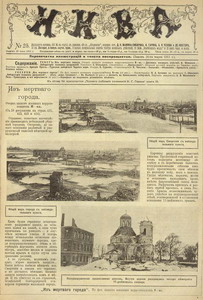
Defence of Smorgon
 The Russian soldiers say that who hasn’t taken part in the battle near Smorgon, those haven’t fought in this war. In the First World War, Smorgon was the region where was the most strained military situation on the German-Russian front during the whole First World War.
The Russian soldiers say that who hasn’t taken part in the battle near Smorgon, those haven’t fought in this war. In the First World War, Smorgon was the region where was the most strained military situation on the German-Russian front during the whole First World War.
In the summer and fall of 1915, the Russian army restraining the attack of the entire Austrian army and forty German divisions retreated to the east. In the beginning of September of 1915 the front line covered the territory from the Baltic Sea – west of Vilnius – east of Grodno and further towards the south, to the Carpathians (the Russian troops left Brest-Litovsk on 25 August, Grodno – on 2 September).
When the German command had redistributed the troops, they began a new offensive. For their breakthrough they chose the territory to the north of Vilna, between the Russian Northern Front and the Western Front. The territory for the German breakthrough covered 30 km, and the correlation of forces was on their side – 6 infantry and 4 cavalry divisions against 4 cavalry and 7 infantry battalions of the Russian troops. The progress of the German army began on 9 September, 1915. By the morning of 10 September a gap of 50 km had appeared between the fronts of the Russian troops. On 11 September, the German command knowing it ordered the 6th Cavalry Corps under the command of General O. von Garnier to stop and in the morning of 12 September to turn to the south towards Swieciany (Svencionys) – Smorgon – Maladzechna. Providing the breakthrough, the German army intensified attacks on Lida, Navahrudak, Baranovichy.
In the morning of 15 September, the German Cavalry Regiment of the 1st Cavalry Division with the support of artillery and machine guns attacked Smorgon – a little town with the population of 16 thousand people in 90 km east of Vilna. When the Russian forces had incurred losses, they withdrew to Krevo in the direction of the coming troops of the 2nd Army. The town’s population was quickly evacuated.
When the 4th Siberian and 36th army corps had come on 20 September, they forced the German cavalry to move back to the river Viliya and occupied Smorgon. And on 24 September, the Guards Corps under the command of General Olokhov – 572 officers, 23 920 infantry battalions, 1 080 cavalry sabres, 145 guns and 5 airplanes – came into the city. Elite regiments of the Russian army were ordered to fight to the death, keep Smorgon and do not let pass the enemy in the direction of Minsk – Moscow.
In September of 1915, the retreating Russian units near Smorgon managed to stop the enemy for the first time during the war. There began a fierce battle for a small Belorussian town. The battle lasted 810 days became one of the most heroic pages of the war for the Russian army. In October 1915, the Germans used gases for the first time there. In the further months gas attacks became an integral part of conventional warfare. By the end of 1915 the enemy forces were exhausted. The Germans strengthened their defense: poured their firing points and bunkers by concrete. The number of labyrinths consisting of trenches increased every day, tens of kilometers of railways which were usual suitable for the move of heavy artillery equipment used for the transportation of ammunition and evacuation of the wounded were built on both sides of the front near Smorgon, erected numerous bridges and ferries across the Viliya.
In September of 1916, the Russian troops conducted their first cloud attack. As a result, in the district only the "gas war" claimed the lives of tens of thousands of soldiers and officers.
There was also "underground war". Within a month the Russian soldiers dug a tunnel to the rear of the Germans – to the top point of the "Golden Hill" on the northern outskirts of the town where there was a German artillery battery and a concrete observer post. On the day of the assault, the point was taken after they had exploded the laid underground dynamite.
The battle in Smorgon became the place of one of the last offensive operations of the Russian army on the Western Front. In July 1917, after three days of powerful artillery preparation there was made an attempt to break through the German line of defense in the area between Smorgon and Krevo. The operation was conducted by Commander of the Western Front General A. Denikin. However, despite the considerable superiority in the number of troops and artillery – 16 infantry divisions, 2 cavalry divisions, about 900 guns from the 13-day norm shells, – the offensive failed. It happened as political events began to affect the army, revolutionary agitation appeared, discipline worsened, cases of desertion became more often.
On the territory of Belarus the First World War had the most noticeable impact on Smorgon. During the years of the war, the both parties built here many kilometers of the line of defense, advanced communications systems which extended from Lake Vishnevsky in the north to the Western Berezina in the south. A huge number of cemeteries are placed on the both sides of the front line.


